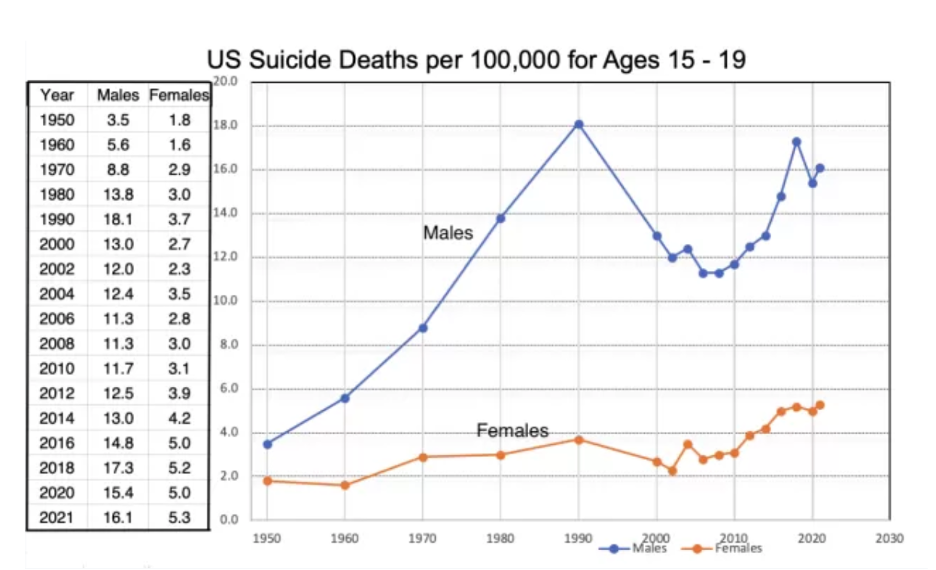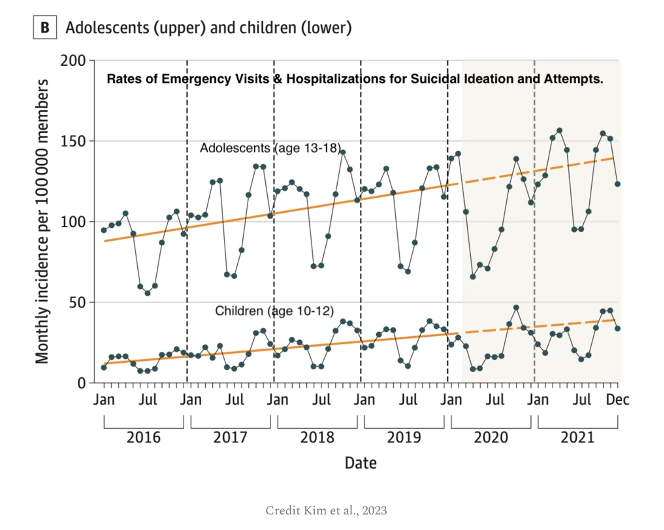What is Causing the Adolescent Mental Health Crisis?
Hint: It's not our phones that are making this generation "anxious"
If you spend any time reading popular media about the adolescent mental health crisis, you most likely came away with the following idea:
We have an adolescent mental health crisis because phones and screens are isolating our young people. We must ban and restrict phone usage for the health and wellbeing of our adolescents.
If this sounds familiar to you, then you are much like some of the attendees at the Association Montessori Internationale USA Montessori Experience conference, whom I spoke in Oklahoma City, where I presented research on the adolescent mental health crisis.
And, if that is your impression, you would be wrong.

Now before you click away, or try to combat me in the comments, lets talk about why most people have this impression.
It’s not by accident.
A few years ago, Johnathan Haidt published his book, The Anxious Generation, that claims to use research to show how phones and social media are to blame for poor mental health among our young people. That book is a New York Times bestseller and Haidt has spent his time speaking at education conferences and schools about his book ever since its release.
Yet the reality is, Haidt is not a genuine, or reliable, expert on this topic.
We first must address the fact that he is a eugenicist who subscribes to the racist idea that IQ and intelligence are determined by race. Consider the following excerpt from an article in The Guardian from 2018:
“Even the prominent social scientist Jonathan Haidt has criticised liberals as “IQ deniers”, who reject the truth of inherited IQ difference between groups because of a misguided commitment to the idea that social outcomes depend entirely on nurture, and are therefore mutable.
Defenders of race science claim they are simply describing the facts as they are – and the truth isn’t always comfortable. “We remain the same species, just as a poodle and a beagle are of the same species,” Sullivan [another eugenicist] wrote in 2013. “But poodles, in general, are smarter than beagles, and beagles have a much better sense of smell.”
Of course, the idea that IQ is related to your race, or that different races of humans are comparable to the difference between poodles and beagles, is entirely pseudo-scientific.
It is simply false.
And yet, this is the backdrop of Haidt’s research and view on the world.
You might be wondering: what about the claims and research he cites in his book? He merely reviewed the research, rather than conducted it himself.
Could it still be accurate?
When psychology scholars reviewed Haidt’s findings, it was clear to them that what he wrote in the book was a blatant misrepresentation of his findings in order to incite a moral panic and to sell as many books as possible.
Candice Odgers, Professor of Social Science and Informatics at UC Irvine, who many would agree is the leading US researcher on the relation of social media to teen mental health, had this to say about The Anxious Generation:
“Two things need to be said after reading The Anxious Generation. First, this book is going to sell a lot of copies, because Jonathan Haidt is telling a scary story about children’s development that many parents are primed to believe. Second, the book’s repeated suggestion that digital technologies are rewiring our children’s brains and causing an epidemic of mental illness is not supported by science. Worse, the bold proposal that social media is to blame might distract us from effectively responding to the real causes of the current mental-health crisis in young people.”
Peter Gray, who is a professor of psychology at Boston College and a personal friend of Haidt’s, has carefully debunked the research Haidt cites. Per Gray’s reading, the conclusions that Haidt draws are simply not what the research points to.
At this point, you may be wondering: If phones aren’t causing the adolescent mental health crisis, then what is?
An Inconvenient Truth: We Must Abolish the Institution of School
When I began researching the adolescent mental health crisis, I was aware of the critiques of Haidt’s work. Given that phones and social media aren’t actually causing the mental health crisis among adolescents, what was?
What became clear to me through a review of scholarship from the last seven years is that the institution of traditional schooling itself is the cause of the adolescent mental health crisis.
Consider suicide rates among young people.
They spike from September to May, and drop from June to August.
Adolescents reported on CDC surveys that pressure to get good grades is the area of their lives where they are pressured the most.
We also see a huge spike in adolescent suicides after 2010, when schools implented the Common Core State Standards, which ushered in a new era of “drill and kill” rote instruction in order to satisfy test score requirements.

This is not because something is wrong with our adolescents, or because they need to “toughen up.”
The traditional institution of schooling is a carceral system which sees students as objects of control. Such a system requires compliance and a lack of autonomy.
What my research uncovered is that when people are put in environments where they are controlled, where their autonomy is taken from them, they exhibit antisocial behaviors. They want to separate themselves from others, to actively put others down if it means increasing their own circumstances. Conditions of control lead to poor mental health and separation from community.
Look around our country and you will see that this is the true outcome of our traditional system.
However, the research also showed that the opposite is true.
When we give people autonomy, when we allow them to have control over their lives, they flourish. They exhibit pro-social behaviors, seeking to help others and live in interdependence. Conditions of autonomy lead to strong mental health.
This comes from Self-Determination Theory; and the research I found argued that being pro-social and living in interdependence with others is actually our human nature, if given the right environment.
But What About The Phones?
When I interviewed Tom Brown on a podcast for Breaking the Paradigm, he said something that is uniquely related to the adult reaction to adolescent phone use.
"Adults control in children what we hate about ourselves.”
You can check out the full episode here:
I once witnessed a head of school tell my adolescents, who were asking for (very) minor changes to an unexpected, authoritarian phone policy, that their phones were the equivalent of heroin, and that the policy was for the good of those students.
This head of school, and their entire administrative team, had their phones out, face up, on the table during this entire meeting. To my adolescents, the hypocrisy was obvious.
Are digital technologies, like phones and social media, designed to make us addicted so we keep coming back for more? Yes, we know that to be true.
But the reality is that we adults have not done our work to curb our own phone usage. We’re scared of phones because we haven’t developed the self control to put them away at dinner or place them outside of our bedrooms at night.
So instead of working with young people to help them develop healthy habits around technology, we control it out of fear.
And in our fear, we create an environment where we strip our young people of autonomy, where they never learn the skills to use technology in a healthy way, and where they are prone to develop antisocial behaviors because they lack the autonomy that they deserve.
Now What? An Invitation to Look in The Mirror
If we take this research seriously, it means we as educators must have hard conversations with each other about where our educational environments force control and compliance.
We must commit ourselves to uprooting these aspects of our schools because they are actively harming our young people.
This can be difficult to do because we justify our actions by saying that our control is in the “best interest” of our young people. But the reality is that this justification is a thin veil for our fear of what our students will do if we truly give them autonomy and control over their learning and lives.
I don’t have all the answers, and if we are going to give young people autonomy and control over their lives and education, we must be prepared to embrace uncertainty and trust that they will make the right decisions for themselves.
If you want to check out the poster, you can check it out below! I will be continuing to dig into this research, with a full research article being published in 2025, so stay tuned!
How are you giving students autonomy and control in your learning environments?
It’s so important for me to acknowledge those who supported me in the journey of curating the research and creating this poster.
I want to thank my adolescent diploma cohort colleagues for their input with this research, and to Tina Booth and Colin Palombi for supporting my research and making it an intentional part of the diploma process. A special thanks to Ayize Sabater who encouraged me to submit my research for consideration and to Kelly Jonelis, who co-founded First Intention with me!
Thanks for Stopping By!
If this work resonates with you, I invite you to consider becoming a paid subscriber. It is a great way to support this work so I can continue to bring thoughtful interviews and blogs to you all year long! Thank you so much for your continued support!
Breaking the Paradigm is a division of Developing Education, which is on a mission to transform education globally to foster human development and flourishing for all people.
First Intention: Curriculum and pedagogy support for Montessori adolescent practitioners, specifically with math and language across the prepared environment.
The Enlightened Educator Project: Supporting educators with mindfulness and resiliency through professional development and downloadable resources.










I understand your point of view. Thanks for elaborating it further. I agree that any policy change shouldn’t be to make the life of adults easy but should be made to address the developmental need of the students. When you speak about tecnology being part of the society they are going to enter, I am reminded of Montessori’s quote in Childhood to Adolescence when she says, “…man must raise himself to a state that is higher than his natural state and the land-child must see that society is in a state of ascent from nature in which he, as a civilised and religious man must play his part.” She also says “But the thing that is important above everything else is that the adolescent should have a life of activity and variety.” I think that adolescents not finding ‘real’ activity and variety resort to using their devices and no matter how many discussions they and we have about the use of technology, they do not have a full life that supports ‘real’ work that is developmentally joyful instead. Montessori says this too - “The environment must make the free choice of occupation easy, and therefore eliminate the waste of time and energy in following vague and uncertain preferences.”
I think these are important points for consideration. If we push for traditional systems to be overhauled, do we have the courage to overhaul our own Montessori school systems and meet the needs of adolescents who need time away from family? Why do we come up with alternatives like camping and limited time away and not give them the whole thing with residential life in our schools?
Thanks for quoting me, Andrew! I support a lot of what you are saying here, but I want to push back a little, and I am interested in your response.
I think it is fair to say that phones aren't the single cause of the adolescent mental health crisis. I agree that Haidt overstates the research and is profiting off of moral panic. But I'm not sure it's fair to just supplant one single cause with another. Although the evidence doesn't show that phones and social media are the sole or main driver of the adolescent mental health crisis, they are surely playing a role. I also think his book has helped raise awareness of the issues with phone use in childhood/adolescence and has given schools/parents some language to tackle these issues in their homes/communities. The issue lies with schools/parents that then take this to the extreme and implement authoritarian measures of controlling tech/phone use.
I also think you go a little far with your dismissal of Andrew Haidt. I broadly agree with the ideas in his book - children need more free play, more autonomy, and less screen time. That we "overprotect children in the real world and underprotect them in the virtual world". His recommendations also seem common sense to me as a parent and teacher:
"Give children far more time playing with other children. This play should ideally be outdoors, in mixed age groups, with little or no adult supervision.
Look for more ways to embed children in stable real-world communities. Online networks are not nearly as binding or satisfying.
Don’t give a smartphone as the first phone. Give a phone or watch that is specialized for communication, not for internet-based apps.
Don’t give a smartphone until high school. This is easy to do, if many of your child’s friends’ parents are doing the same thing.
Delay the opening of accounts on nearly all social media platforms until the beginning of high school (at least)."